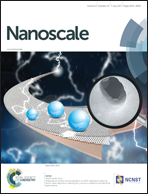Unusual infrared absorption increases in photo-degraded organic films†
Abstract
Degradation is among the most pressing problems facing organic materials, occurring through ingress of moisture and oxygen, and light exposure. We determine the nanoscale pathways underlying degradation by light-soaking organic films in an environmental chamber, and performing infrared spectroscopy, to identify atomic bonding changes. We utilize as a prototype the low band gap PTB7-PCBM blend. Films light-soaked in the presence of oxygen show unusual increased absorption at 1727 cm−1 attributable to increased C![[double bond, length as m-dash]](https://www.rsc.org/images/entities/char_e001.gif) O modes, and a broad increase at 3240 cm−1 attributable to hydroxyl (O–H) groups bonded within the organic matrix. Films exposed to oxygen in the dark, or light-soaked in an inert atmosphere, do not exhibit significant absorption changes, suggesting simultaneous exposure of oxygen and light that creates singlet excited oxygen is the detrimental factor. Our ab initio electronic structure simulations interpret these by oxidation at the α-C site of the alkyl chains in PTB7, with an irreversible rupture of the alkyl chain and formation of new C
O modes, and a broad increase at 3240 cm−1 attributable to hydroxyl (O–H) groups bonded within the organic matrix. Films exposed to oxygen in the dark, or light-soaked in an inert atmosphere, do not exhibit significant absorption changes, suggesting simultaneous exposure of oxygen and light that creates singlet excited oxygen is the detrimental factor. Our ab initio electronic structure simulations interpret these by oxidation at the α-C site of the alkyl chains in PTB7, with an irreversible rupture of the alkyl chain and formation of new C![[double bond, length as m-dash]](https://www.rsc.org/images/entities/char_e001.gif) O and C–O–H conformations at the α-C. Infrared spectroscopy coupled with ab initio simulation can provide a powerful tool for quantifying photo-structural atomic bonding changes. Understanding nanoscale light-induced structural changes will open avenues to designing more stable organic materials for organic electronics.
O and C–O–H conformations at the α-C. Infrared spectroscopy coupled with ab initio simulation can provide a powerful tool for quantifying photo-structural atomic bonding changes. Understanding nanoscale light-induced structural changes will open avenues to designing more stable organic materials for organic electronics.



 Please wait while we load your content...
Please wait while we load your content...